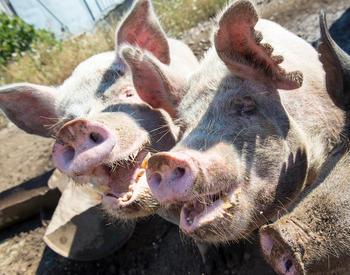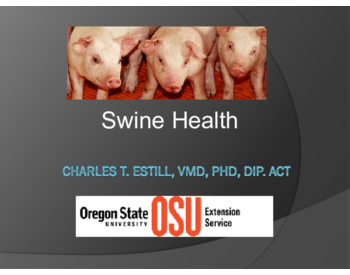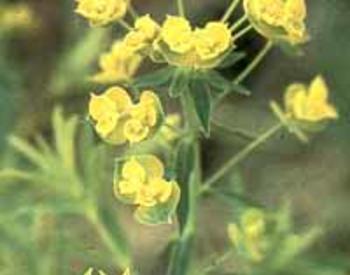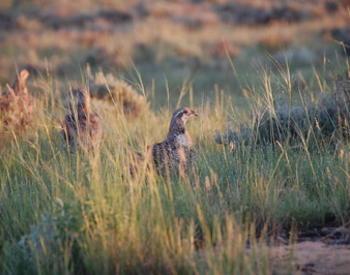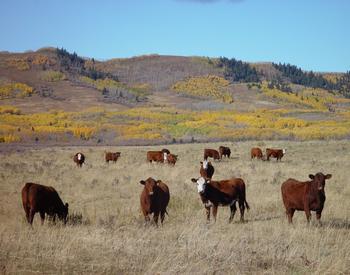Changing consumer preferences and values are creating opportunities for niche meat producers. One of these opportunities is pasture-based pork production. The purpose of this article is to help potential producers understand the benefits of and concerns about a pasture-based production system so problems can be avoided and success is more likely.
Pigs are not ruminants
Humans and pigs are similar in many ways, not the least of which are our digestive tracts. Pigs and humans are monogastrics, meaning we have one major stomach compartment and rely primarily on enzymes for digestion (Figure 1). This is in contrast to ruminants, which have three pre-stomach chambers devoted to fermentation of feedstuffs and an enzymatic stomach as well. Pigs and humans are omnivores and can eat and digest a wide range of foods. Ruminants are herbivores and can eat and digest plant materials, thanks to the microbes living in their rumen.
Rumen microbes ferment ingested feed into its component parts (amino acids and carbohydrates) and use these components to make more microbes. The host can use these amino acids, carbohydrates, and the microbes themselves as sources of nutrients. Microbes can upgrade the quality of protein in a ruminant’s diet to microbial protein as long as sufficient nutritional building block components are available. Consequently, ruminants have no requirement for essential amino acids that must be included in their diet — microbes synthesize all the amino acids needed.
In contrast, both pigs and humans have dietary essential amino acid requirements for optimal health and growth. Humans have nine essential amino acids: histidine, isoleucine, leucine, lysine, methionine, phenylalanine, threonine, tryptophan and valine. Pigs require those nine plus arginine. Humans and pigs can synthesize the remaining amino acids they need for growth and maintenance.
Why provide all this information on anatomy and nutrition as an introduction to discussing pastured pigs? Potential pastured-pig producers must be purposeful in pursuit of pork perfection. Just as you can’t make a silk purse out of a sow’s ear, you can’t make a ruminant out of a monogastric. Unless animals are properly fed and managed, pastured pork production will not be sustainable at any level or from any standpoint. Three major elements that must be considered for sustainable agricultural endeavors are: environment, profitability and society. A core component at the center of these for livestock enterprises is animal welfare.
Why confinement?
Raising hogs on pasture is nothing new; it was the traditional method of hog production and management for generations. However, as the human population grew and the demand for affordable protein increased, pork and other livestock production operations grew bigger and more centralized to meet this need.
Since the 1950s, the U.S. animal agriculture industry placed increased emphasis on efficiency to decrease costs and increase production. A major management change included bringing feed to animals, in part to reduce their nutritional requirements and feed wastage. Hog production changed to nearly all confinement systems for the following reasons:
- Improved sanitation.
- Increased baby pig survival.
- Better disease and parasite control.
- Faster rates of gain.
- Better predator control.
- Increased carcass quality assurance.
- Better environmental temperature regulation.
- More use of technology for labor savings.
- Targeted nutrition for various stages of growth.
- Increased efficiency for reduced costs to consumers.
In 1959, the national average of piglets per litter was 6.5 (6.0 for Oregon and 5.5 for Washington). In 2014, the national average was 10.25 piglets per litter. These gains in production and efficiency are the result of management changes including increased biosecurity measures, targeted nutrition, controlled environmental temperatures, genetic selection and reduced piglet mortality from maternal crushing.
Increased efficiency in the hog industry over the last 50 years has national pig producers using 78% less land and 41% less water while producing twice as much pork with a 35% smaller carbon footprint. Despite a 39% reduction in the national breeding herd, 29% more hogs are sold now. A specific example of this increased efficiency in the last five decades: 1,000 lbs. of retail pork are now produced by five market animals instead of eight.
Everything old is new again
Despite the advantages of confinement and semiconfinement production mentioned above, there are definite disadvantages to this system and advantages to pasture-based production. As some consumers become increasingly concerned with the quality of life their food had, niche producers are able to produce food animals using methods more in keeping with some consumers’ preferences.
Consumers envision animals raised outdoors as having a more “natural” and “happier” life. Pasture-based hog production can meet the needs of this audience as long as specific concerns can be addressed as delineated below.
Basic components of animal welfare
Regardless of the production system used, producers are obligated to address the following aspects of animal welfare at all stages of production:
- Provision of shelter, water and adequate diet.
- Attention to health care to prevent illness and treat when necessary.
- Prevention of pain and suffering and projection from injury.
- Opportunity to engage in normal behavior.
Outdoor systems certainly allow pigs to partake in normal behavior more than they can in most indoor systems. Pigs can root, wallow, seek shade or sun, forage for food, interact as they please with each other, breathe fresh air and explore their surroundings.
However, outdoor production can put hogs at more risk of some problems, including sunburn, parasites, predator attack, fence injuries, heat stress, hypothermia, toxicities and malnutrition. Managers must address each one of these risks to keep pigs safe, healthy and growing well in outdoor systems.
Effects of hogs on the environment
Like all livestock, hogs can create beneficial or detrimental environmental impacts based on how they are managed. Too many livestock on too little land is the No. 1 mistake made by new and experienced producers alike.
This problem and the resultant injury to natural resources can be prevented by creating a Whole Farm Plan before any animals are even purchased. Some sites are better suited to hogs than others and the carrying capacity of various parcels can differ greatly. Successful future producers make their big mistakes on paper during planning stages, not in real life.
With excellent management and pasture rotation, pigs can be used as a tool to improve some landscapes. They can aerate compacted soil through rooting, eliminate some unwanted plants such as blackberries, increase soil activity and seed-to-soil contact through hoof action, and add high-quality nutrients to the soil through urine and manure.
On the other hand, poorly managed hogs (such as feral hogs and overstocked premises) can destroy streambanks, seriously disrupt soil structure, create problematic wallows, kill desirable trees and plants, create objectionable odors, escape and damage neighbors’ property, and contract diseases by eating wildlife carcasses. Indeed, poorly managed pigs can create barren wastelands in no time. Good fences, adequate food, shelter, plenty of water, sufficient acreage, frequent rotation and daily oversight can help prevent most of these negative impacts.
Pigs can't survive on plants
Getting back to nutrition and gastrointestinal anatomy, keep in mind that pigs are not ruminants. Because they lack a rumen and fiber-digesting microbes, pigs are unable to digest fiber well. They cannot survive on plants alone! (The same goes for poultry.) This is a major misconception of some new pig and poultry producers, who think they can leave these animals to their own devices and reap the rewards of a fabulous carcass in a few months. Not true!
Pasture should be considered a nutritional supplement and playground for monogastric animals, not the main source of their nutrition. Pigs on pasture have a great time rooting for grubs, worms, beetles, mushrooms, mice, roots, bird eggs and who-knows-what else. However, this is not a balanced diet.
Specific crops can be planted for hogs to harvest, including mangles and other root crops. This will still not be a balanced diet. After all the high protein and high energy sources have been eaten, all that is left is high-fiber plants, unless excellent pasture management practices are employed.
Yes, pigs will happily forage on plants, but this is like humans eating a salad: It tastes good but its main effect is to add bulk to the diet and provide the benefits of fiber. Humans eating just salad and pigs eating just forage will lose weight because they are physically full before they have met their nutritional needs and they are unable to digest and use most of the food eaten.
Pigs are able to ferment and digest fiber to some degree thanks to bacterial action in their large intestine and cecum, but this only helps boost energy utilization a bit; any bacterial protein upgrading benefits are lost in feces. In the past, most nutritionists recommended feeding no more than 10% of a pig’s diet as forage, because it serves as fill and takes the space of a balanced and more nutrient-dense and digestible diet.
Current thinking is pigs can digest more fiber than previously believed, but digestibility is very much dependent on plant maturity (the younger the plant, the more digestible). A pig’s ability to utilize forage can increase with age and adaptation to the diet. They also digest legumes much better than grasses.
Young growing pigs are extremely efficient at protein synthesis and growth when eating a balanced diet. However, this rapid growth requires high dietary protein levels (see Table 1). Most pasture grasses will have 8% to 11% crude protein on a dry matter basis, which cannot sustain maintenance nutritional needs, let alone high rates of growth. Legumes such as clover and alfalfa have much higher protein content — often 17% or more — but even they cannot meet the protein needs of growing pigs unless additional sources are provided.
| Pig weight (lb.) or stage | 6.6-11 | 11-22 | 22-44 | 44-110 | 110-176 | 176-264 | Gestating Sow | Lactating sow | Mature boar |
|---|---|---|---|---|---|---|---|---|---|
| % CP requirement | 26-28 | 23.7-26 | 20.9-22.5 | 18-18.5 | 15.5-16 | 13.2-14 | 12-13.5 | 13-19 | 13-20 |
Danger, Will Robinson!
What is the main predator of pigs on pasture? Sadly and surprisingly, the answer is dogs (coyotes are No. 2). In some areas, bears and cougars are threats to even adult pigs; raccoons can attack baby pigs. Predator-proof pig premises with protective perimeter fences.
Sunburn risks can be mitigated by using pigmented breeds and providing access to shade. Sunblock should not be used without consulting your veterinarian because the use of any unapproved medication on food animals is illegal unless under a veterinarian’s supervision.
Pigs do not sweat so they can be quite easily affected by excess heat. Shade is essential, as is unlimited cool drinking water and wallowing areas. Keep wallows shaded so the water and mud there are cooler than the environment. If needed, spray pigs periodically with large water droplets and let them dry between treatments.
It is best to act proactively during times of increasing temperatures to prevent heat stress instead of reacting to overheated pigs. Late gestation, lactating, and nearly finished pigs are at most risk of heat stress.
As mentioned, pastured hogs are excellent at rooting up things to eat, but this skill can sometimes be to their detriment. Poisonous plants that pigs can consume include elderberry, Prunus species (cherry family), rhubarb, pokeweed, Golden Chain tree, lambsquarter, pigweed, fiddleneck (tarweed), iris, and the mustard family (cabbage, turnips, broccoli, mustard) to name a few. Walk your pasture and identify all plants your pigs could access; remove or fence out toxic plants.
Is pasture the right choice?
Pasture access can be an excellent addition to a hog farm’s management plan. As mentioned, it can have beneficial effects on animals and the environment. Some pig breeds are more adept at foraging than modern commercial composite hogs. Breeds more likely to thrive on pasture include heritage (rare) breeds such as Tamworth, Large Black, Mangalitsa and the very rare Mulefoot. There is a strong market for such breeding stock, so becoming a breeder is another opportunity to consider.
What about piglets on pasture? These little guys are protein-synthesizing factories. Their maintenance requirements will certainly increase on pasture due to increased activity and more variable environmental temperatures. They definitely need nutritional support in addition to whatever the pasture provides.
In general, pasture is not recommended for piglets under 40 pounds due to their very high nutritional needs. Bear in mind that most will need more time to reach butcher weight than those held in confinement.
The variable diet can be a source of inconsistent but interesting meat flavors; consumers should be apprised of this. (This should be an easy sell because one of the reasons consumers are turning to pastured pork is for a more flavorful product, with less emphasis on leanness than in the past and more on taste and texture).
Provide plenty of shelter and safe zones for piglets to protect them against predators (including raptors) and the elements.
Adult animals can truly benefit from pasture access. It encourages movement and improves feet and leg health (see photo). Air quality and ventilation issues are usually eliminated and respiratory health can improve.
The challenge to find something to eat is good mental stimulation for pigs, which are extremely smart animals; they also seem more content than when their nutritional needs are met in a more concentrated form. With supplementation of energy, protein, vitamins and minerals as needed for a balanced diet, it is easy to be supportive of pasture access for adult animals maintaining themselves.
Gestating animals will need additional nutrition and should be monitored closely to be sure their needs are being met, but forage is an excellent way to prevent constipation in pregnant sows. Pasture is not widely recommended for lactating animals due to their higher nutritional needs, but some producers routinely farrow on pasture successfully. These sows can probably not support the 14-plus piglet litters raised by some sows in confinement, but the choice of production systems is based on the producer’s goals, priorities and values.
Be careful not to overestimate the amount of forage in a particular pasture. Foraging pigs will waste and destroy a significant amount of the forage. Plan on about 50% of what is standing in the field not being available as feed.
P.S. Pigs are not ruminants
The key to success as a pasture-based pork producer is to know and address the challenges involved. Understand pigs will need to have additional nutrients provided. Realize young pigs will gain more slowly and be older at traditional market weights. Recognize pasture-raised pork can have variable taste and other carcass attributes due to more variables in production. Address threats to pig safety and health while on pasture.
Being proactive about problems, keeping excellent records, attending educational workshops, finding and learning from experienced mentors, starting with and maintaining healthy animals, and being willing to change practices based on outcomes will help create a successful pasture-based pork enterprise. Consistently surpassing your customers’ expectations with wholesome and delicious pork products will help your business thrive.
Resources and references
